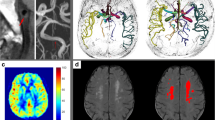Abstract
Introduction
Homozygous familial hypercholesterolemia (FH) is considered a model disease for excessive plasma cholesterol levels. Patients with untreated homozygous FH have a markedly increased risk for premature atherosclerosis. The frequency and extent of ischemic brain damage detectable by high-field magnetic resonance imaging (MRI) after long-term intensive treatment are unknown.
Methods
In a case control study, five patients with homozygous FH (one male and four females; mean age: 23.6 ± 9.2, range: 12–36 years; mean pre-treatment serum total cholesterol level: 26.9 ± 3.24 mmol/L; all patients with documented atherosclerotic plaques in the carotid arteries) and five age- and sex-matched healthy controls were studied. All patients had been on maximal lipid-lowering medication since early childhood, and four of them were also on treatment with low-density lipoprotein (LDL) apheresis at bi-weekly intervals. Brain MRI was performed at 3 Tesla field strength with fluid-attenuated T2-weighted inversion recovery and T1-weighted spin-echo MR pulse sequences and subsequently evaluated by two independent readers.
Results
The maximal lipid-lowering treatment reduced the total serum cholesterol by more than 50% in the patients, but their serum concentrations were still 3.6-fold higher than those found in the controls (11.9 ± 4.2 vs. 4.5 ± 0.5 mmol/L; p < 0.0047). No brain abnormality was observed in any of the patients with homozygous FH.
Conclusion
Homozygous FH patients on intensive cholesterol-lowering therapy have no evidence of ischemic brain damage at 3 Tesla MRI despite the remaining high cholesterol levels.
Similar content being viewed by others

References
Amarenco P, Cohen A, Tzourio C, Bertrand B, Hommel M, Besson G, Chauvel C, Touboul PJ, Bousser MG (1994) Atherosclerotic disease of the aortic arch and the risk of ischemic stroke. N Engl J Med 331:1474–1479
Amarenco P, Labreuche J, Elbaz A, Touboul PJ, Driss F, Jaillard A, Bruckert E (2006) Blood lipids in brain infarction subtypes. Cerebrovasc Dis 22:101–108
Autti T, Raininko R, Vanhanen SL, Kallio M, Santavuori P (1994) MRI of the normal brain from early childhood to middle age. I. Appearances on T2- and proton density-weighted images and occurrence of incidental high-signal foci. Neuroradiology 36:644–648
Baum KA, Schulte C, Girke W, Reischies FM, Felix R (1996) Incidental white-matter foci on MRI in “healthy” subjects: evidence of subtle cognitive dysfunction. Neuroradiology 38:755–760
Braffman BH, Zimmerman RA, Trojanowski JQ, Gonatas NK, Hickey WF, Schlaepfer WW (1988) Brain MR: pathologic correlation with gross and histopathology. 2. Hyperintense white-matter foci in the elderly. AJR Am J Roentgenol 151:559–566
de Leeuw FE, de Groot JC, Achten E, Oudkerk M, Ramos LM, Heijboer R, Hofman A, Jolles J, van Gijn J, Breteler MM (2001) Prevalence of cerebral white matter lesions in elderly people: a population based magnetic resonance imaging study. The Rotterdam Scan Study. J Neurol Neurosurg Psychiatry 70:9–14
Goldstein J, Hobbs H, Brown M (1994) Familial Hypercholesterolaemia. In: Scriver C, Beaudet A, Sly W, Valle D (eds) The metabolic and molecular basis of inherited disorders. McGraw Hill, New York, pp 1981–2030
Horikoshi T, Yagi S, Fukamachi A (1993) Incidental high-intensity foci in white matter on T2-weighted magnetic resonance imaging. Frequency and clinical significance in symptom-free adults. Neuroradiology 35:151–155
Law MR, Wald NJ, Rudnicka AR (2003) Quantifying effect of statins on low density lipoprotein cholesterol, ischaemic heart disease, and stroke: systematic review and meta-analysis. Br Med J 326:1423
Naoumova RP, Thompson GR, Soutar AK (2004) Current management of severe homozygous hypercholesterolaemias. Curr Opin Lipidol 15:413–422
Postiglione A, Nappi A, Brunetti A, Soricelli A, Rubba P, Gnasso A, Cammisa M, Frusciante V, Cortese C, Salvatore M et al (1991) Relative protection from cerebral atherosclerosis of young patients with homozygous familial hypercholesterolemia. Atherosclerosis 90:23–30
Soljanlahti S, Autti T, Lauerma K, Raininko R, Keto P, Turtola H, Vuorio AF (2005) Familial hypercholesterolemia patients treated with statins at no increased risk for intracranial vascular lesions despite increased cholesterol burden and extracranial atherosclerosis. Stroke 36:1572–1574
Thompson GR, Miller JP, Breslow JL (1985) Improved survival of patients with homozygous familial hypercholesterolaemia treated with plasma exchange. Br Med J (Clin Res Edn) 291:1671–1673
Tosi I, Toledo-Leiva P, Neuwirth C, Naoumova RP, Soutar AK (2007) Genetic defects causing familial hypercholesterolaemia: Identification of deletions and duplications in the LDL-receptor gene and summary of all mutations found in patients attending the Hammersmith Hospital Lipid Clinic. Atherosclerosis (in press) (Epub: 13 November 2006) DOI 10.1016/j.atherosclerosis.2006.10.003
Vaughan CJ, Delanty N (1999) Neuroprotective properties of statins in cerebral ischemia and stroke. Stroke 30:1969–1973
Vermeer SE, Hollander M, van Dijk EJ, Hofman A, Koudstaal PJ, Breteler MM (2003) Silent brain infarcts and white matter lesions increase stroke risk in the general population: the Rotterdam Scan Study. Stroke 34:1126–1129
Conflict of interest statement
Declan O’Regan receives a PhD stipend from Schering Health Care UK.
Author information
Authors and Affiliations
Corresponding author
Rights and permissions
About this article
Cite this article
Schmitz, S.A., O’Regan, D.P., Fitzpatrick, J. et al. MRI at 3 Tesla detects no evidence for ischemic brain damage in intensively treated patients with homozygous familial hypercholesterolemia. Neuroradiology 49, 927–931 (2007). https://doi.org/10.1007/s00234-007-0273-6
Received:
Accepted:
Published:
Issue Date:
DOI: https://doi.org/10.1007/s00234-007-0273-6



